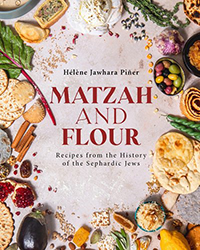
Suares Fried Unleavened Tortillas for Rosh Hashanah
Matute, Spain
The following information is from a Spanish inquisition trial that dates back to the beginning of the sixteenth century. The court of the Holy Office started to sentence the crypto-Jews for their hidden Jewish practices, only twenty-four years earlier.
María García Redondo reported to the court in Almazan on June 6, 1505, that the wife of Francisco Suares, who lived in Matute (La Rioja, Spain), was preparing unleavened bread dough, kneading it with an egg, and adding oil to the dough. She remembers that it was for the period of San Miguel (a feast that falls on September 29, during Rosh Hashana) and that she made three tortillas and a small cake, and that the cake with meat in it was eaten by a child she saw.
“[Maria] saw the wife of the aforementioned Francisco [Suares], whose name is unknown, kneading unleavened bread [pan cenceño], that is to say, bread without yeast. She kneaded it with one egg and added oil to the […] dough. And she remembers it was for San Miguel, and that she made three tortillas.”
Those fried tortillas can be paired with beef made from a beef stew. The beef would need to be shredded and placed in the middle of the fried tortilla. The fried tortilla could also be dipped briefly in the beef stew broth and the shredded meat could be placed on the top.

Image courtesy of the publisher
Serves: 12 tortillas
Time: 1 hour 30 minutes
Ingredients:
2Ѕ cups (375 g) flour
Ѕ teaspoon of salt
2 tablespoons (20 ml) olive oil
⅔ cup + 1 tbsp (150 ml) warm water
1 egg
⅛ cup (30 g) pomegranate syrup,
to drizzle
⅛ cup fresh cheese, like labneh
3 figs, dried or fresh
Oil for frying (such as vegetable
or canola oil)
- In a large mixing bowl, whisk together the flour and salt. Add the olive oil, warm water, and egg to the bowl and mix until a dough forms. Knead the dough on a lightly floured surface for 5 – 7 minutes, until it is smooth and elastic.
- Divide the dough into small pieces. Each one should be 1⅛ oz (30 g), the size of a ping-pong ball. Put them in a plastic bag and cool in the fridge for 1 hour. Roll the dough balls out into thin circles (about 6 inches/15 cm in diameter).
- Heat a large skillet over medium-high heat and add a small amount of oil. Fry the matzah tortillas one at a time, flipping once, until they are lightly browned on both sides (about 1 minute on each side).
- Remove the matzo from the skillet, drizzle with pomegranate syrup, and dip into fresh cheese and eat with figs. If desired, you can break the matzot into small pieces and fry them in oil until they are crispy.
Excerpted from Matzah and Flour: Recipes from the History of the Sephardic Jews, by Hélène Jawhara Piñer published by Academic Studies Press.
Hélène Jawhara Piñer holds a doctoral degree in Medieval History and the History of Food. In 2018, she was awarded the Broome & Allen Fellowship of the American Sephardi Federation (asf), dedicated to recognizing outstanding academic accomplishments and services to the Sephardic community, as well as encouraging continued excellence in the field of Sephardi studies. As a research associate of the Centre for Advanced Studies in the Renaissance(CESR) and of the Cooking of Recipes of the Middle Ages (CoReMa) research program in Tours, Dr. Jawhara-Piñer’s main research interest is the medieval culinary history of Spain through inter- and multiculturalism, with a special focus on the Jewish culinary heritage in Arabic. Her recipes have appeared in Sephardi World Weekly, Tablet Magazine, The Forward, and S&P Central’s Newsletter. She attended The Great Big Jewish Food Fest (May 2020) as a presenter for an historical-cooking demonstration. With the collaboration of the ASF, she gives live historical cooking classes for the show “Sephardic Culinary History with Chef Hélène Jawhara Piñer,” available on Chaiflix.



